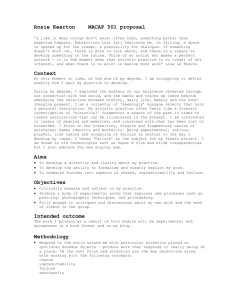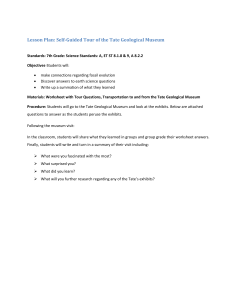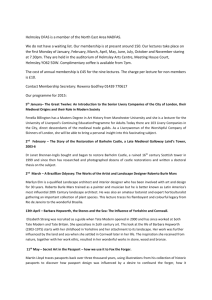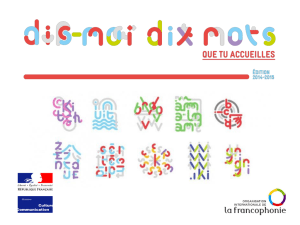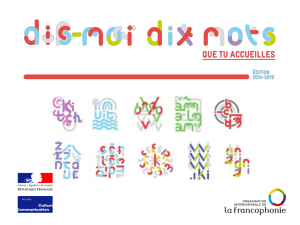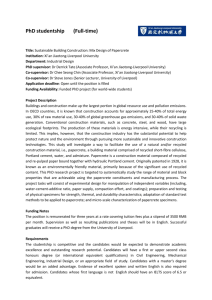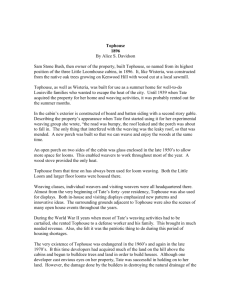Further Information (CCC 2009)
advertisement
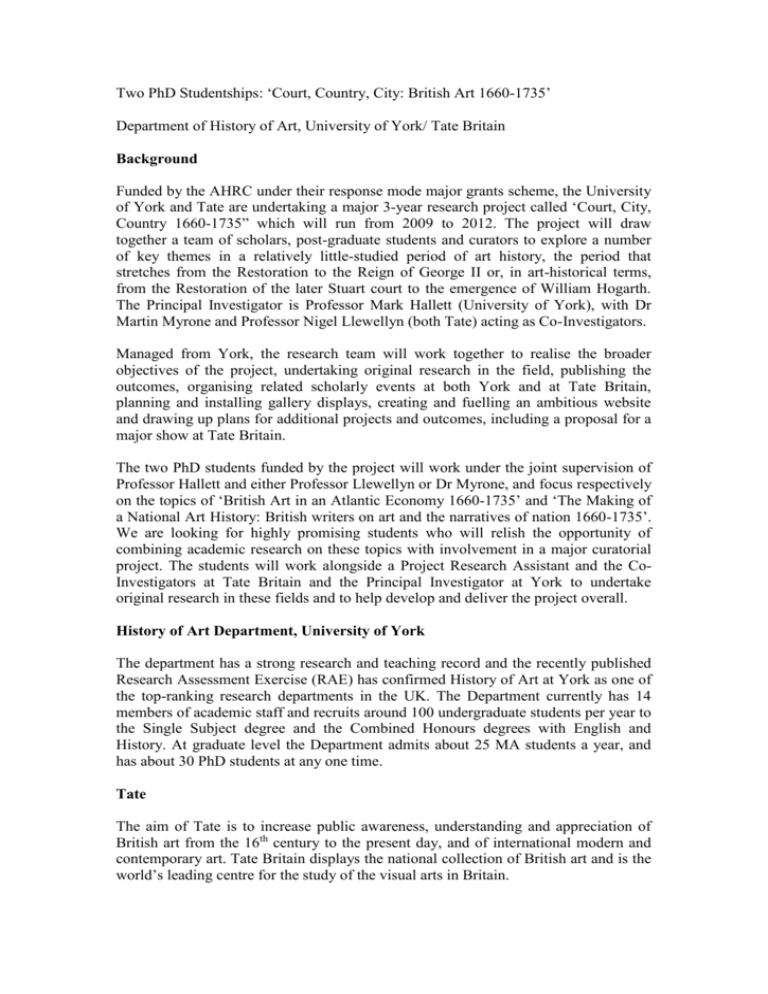
Two PhD Studentships: ‘Court, Country, City: British Art 1660-1735’ Department of History of Art, University of York/ Tate Britain Background Funded by the AHRC under their response mode major grants scheme, the University of York and Tate are undertaking a major 3-year research project called ‘Court, City, Country 1660-1735” which will run from 2009 to 2012. The project will draw together a team of scholars, post-graduate students and curators to explore a number of key themes in a relatively little-studied period of art history, the period that stretches from the Restoration to the Reign of George II or, in art-historical terms, from the Restoration of the later Stuart court to the emergence of William Hogarth. The Principal Investigator is Professor Mark Hallett (University of York), with Dr Martin Myrone and Professor Nigel Llewellyn (both Tate) acting as Co-Investigators. Managed from York, the research team will work together to realise the broader objectives of the project, undertaking original research in the field, publishing the outcomes, organising related scholarly events at both York and at Tate Britain, planning and installing gallery displays, creating and fuelling an ambitious website and drawing up plans for additional projects and outcomes, including a proposal for a major show at Tate Britain. The two PhD students funded by the project will work under the joint supervision of Professor Hallett and either Professor Llewellyn or Dr Myrone, and focus respectively on the topics of ‘British Art in an Atlantic Economy 1660-1735’ and ‘The Making of a National Art History: British writers on art and the narratives of nation 1660-1735’. We are looking for highly promising students who will relish the opportunity of combining academic research on these topics with involvement in a major curatorial project. The students will work alongside a Project Research Assistant and the CoInvestigators at Tate Britain and the Principal Investigator at York to undertake original research in these fields and to help develop and deliver the project overall. History of Art Department, University of York The department has a strong research and teaching record and the recently published Research Assessment Exercise (RAE) has confirmed History of Art at York as one of the top-ranking research departments in the UK. The Department currently has 14 members of academic staff and recruits around 100 undergraduate students per year to the Single Subject degree and the Combined Honours degrees with English and History. At graduate level the Department admits about 25 MA students a year, and has about 30 PhD students at any one time. Tate The aim of Tate is to increase public awareness, understanding and appreciation of British art from the 16th century to the present day, and of international modern and contemporary art. Tate Britain displays the national collection of British art and is the world’s leading centre for the study of the visual arts in Britain. You can find further information about about the History of Art department at York on www.york.ac.uk/depts/histart and about Tate on www.tate.org.uk The project investigators have identified two topics for investigation by the PhD team-members. They are as follows: 1) British Art in an Atlantic Economy 1660-1735 Under the broad title of 'British Art in an Atlantic Economy 1660-1730', the thesis would develop a series of case studies exploring the material, imaginative and personal links that helped tie Britain into an Atlantic economy during the period. Ashistorians have come increasingly to recognize, the north and south American colonies and the West Indian plantations were a major focus of British overseas investment in these years, and colonization in these regions had profound implications for the shaping of British cultural identity. Effectively tracing the circulation of capital, print and people and finding ways of rethinking British cultural history within this expanded geographical framework are significant challenges. The possibility of considering British art in an Atlantic context is especially provocative, given the assumptions which have traditionally been made about the development of a parochial or 'native' artistic tradition through these decades. The subject offers considerable scope for interpretation. The student would be expected to engage with the historiographical and methodological issues at stake with these questions, and to reflect on the implications of their research for existing narratives of British art. The central focus of research would, however, be on developing case studies drawn from some or all of the following areas: the passage of individual artistic producers between homeland and colonies; the material culture of the Atlantic; the graphic culture of the Atlantic trade; the representation of the Atlantic economy in graphic satire, painting or sculpture. One of the central ambitions of 'Court, Country, City' is to develop an expanded sense of the geographical reach and cultural character of British art in the period. The concept of an 'Atlantic economy' offers an opportunity to extend this effort in a particularly telling way, by playing concepts and narratives developed so persuasively among historians of empire and the economy, within material culture studies and early American studies, against accepted assumptions about the increasingly 'national' qualities of British art in the period. Setting British art and artists in their transatlantic contexts would seem to promise one of the more original ways in which this project can check and extend scholarly and more general assumptions about British art history. The scope of this thesis would be ambitious, and necessarily exploratory, and it is only through dedicated individual research that a proper grasp of the issues and ideas at stake could be developed. The student would acquire expertise in the archival resources and specialist literature, and would thus become a significant link into academic realms beyond the existing expertise of the named team members. The student would be able to make a highly valuable contribution to the project as a whole, both helping to shape display projects and the proposed exhibition in vitally important ways, and opening up new lines of inquiry that would connect these endeavours to broader scholarly issues of imperial and American history, culture and politics. Meanwhile, the transatlantic perspective would be of considerable value in providing opportunities for forms of comparative analysis around those issues of cultural value, artistic identity, patronage and politics which lie at the heart of the project as a whole. 2. The Making of a National Art History: British writers on art and the narratives of nation, 1690-1735. The emergence of an idea of a 'British School' of art has been one of the more fruitful lines of inquiry within recent British art history. Encompassing vital issues of cultural hegemony, artistic identity, and the interpellation of art and politics, the genesis and historiography of the 'British School' have been placed at the centre of debates about British culture in the long eighteenth century. To date, though, the discussion has focussed on the era between the emergence of Hogarth as a 'patriotic' painter and the early nineteenth century, with the ascent of Turner, Constable and a powerful new idea of British national identity. The purpose of this PhD project will be to explore an earlier and yet equally seminal period: the four decades after the Glorious Revolution, when the political, religious and bureaucratic transformations that established the modern British state were effected. The thesis will concentrate on the written accounts of British art that were produced in these years - including the first unpublished notes of George Vertue - exploring the political contexts in which they were produced, their qualities as texts and as interventions in a rapidly transforming cultural scene. Another key area of interest will be the art clubs - notably the Virtuosi of St Luke and the growing opportunities for collective art training in London, which provided the contexts for these literary productions. Central research questions might include: how did the characterisation of art in national terms enforce or contest ideas about national identity? What was the role of existing Continental art theories and practices in the emergence of a discernibly British artistic identity? What was the social character of writing on art and art history during the period? This PhD project would provide an intensively researched and historically specific perspective on the theory and early historiography of British art between 1660 and 1735. In assembling the literary documentation - published and unpublished - that would form a point of historical reference for the questions outlined above, the researcher would also contribute to the development of a critically reflexive dimension to the project as a whole. Beyond the intrinsic value of pursuing the research issues around the historical genesis of the 'British school', this doctoral research would become a vital component of an authoritative new history, overhauling current assumptions about the geography, social reach, quality and character of British art over these decades. Nomination of topic Applicants are encouraged to nominate which of the two topics they would wish to work upon Supervisory arrangements and research resources. The project students would benefit from long-established supervisory arrangements in place at the History of Art department at York. The project students would: attend regular meetings with Professor Hallett and the thesis co-supervisor; benefit from twice-yearly meetings of a Thesis Advisory Panel, which features at least one member of academic staff other than the supervisors of the thesis; and attend the department's research training programme, run by the Deputy Graduate Chair. The project students would also be warmly encouraged to attend the research events organised by the department, by the departmental Research Schools in British Art and Sculpture, by the University's Interdisciplinary Centres for Renaissance and Early Modern Studies (CREMS) and Eighteenth Century Studies (CECS), and by other Humanities departments within the University. The students will also be invited to attend the workshops on dissertation writing and the graduate research lunches organised by the department; give research papers in the department and at the project study-days; and attend the graduate theory reading groups which meet regularly throughout the year. The project students will also liaise closely with the other members of the research team at Tate Britain, and be encouraged to participate in the study-days held in London. Application and appointment deadlines and procedures: The closing date for applications is 5.00 pm on Friday 5 June 2009 We are expecting to interview candidates for these studentships in York on Wednesday 8th July. Further information and application forms are available from the University of York’s Graduate Schools Office: http://www.york.ac.uk/graduatestudy/index.htm. On-line applications are welcome. Informal enquiries regarding the studentships may be made to Professor Mark Hallett, email mlh5@york.ac.uk and to Dr Martin Myrone Martin.Myrone@tate.org.uk
